Wind Direction Extraction from X-Band Marine Radar Images Based on the Attenuation Horizontal Component
Abstract
1. Introduction
2. Wind Direction Retrieval Methods
2.1. Data Preprocessing
2.2. Radar Return Ideal Range Attenuation Model
2.3. Estimation of Attenuation Horizontal Components and Outlier Treatment
| Algorithm 1: Estimation of attenuation horizontal components and outlier treatment |
| Input: ideal range attenuation model , Initialize using Equation (7) ← Estimate the attenuation horizontal components preliminarily using Equation (6) |
| for N = 1:2 ← ← Update with using Equation (8) ← Estimate the attenuation horizontal components using Equation (6) end for Output: |
2.4. Wind Direction Extraction Method
3. Results
3.1. Data Overview
3.2. Wind Direction Retrieval Results
4. Discussion
5. Conclusions
Author Contributions
Funding
Data Availability Statement
Acknowledgments
Conflicts of Interest
References
- Thornhill, E.; Wall, A.; McTavish, S.; Lee, R. Ship anemometer bias management. Ocean Eng. 2020, 21, 107843. [Google Scholar] [CrossRef]
- Zhang, Y.; Liu, F.; Lu, Z.; Wei, Y.; Wang, H. Multi-anemometer optimal layout and weighted fusion method for estimation of ship surface steady-state wind parameters. Ocean Eng. 2022, 266, 112793. [Google Scholar] [CrossRef]
- Wang, H.; Qiu, H.; Lu, Z.; Wang, L.; Akhtar, R.; Wei, Y. An Energy Spectrum Algorithm for Wind Direction Retrieval From X-Band Marine Radar Image Sequences. IEEE J. Sel. Top. Appl. Earth Obs. Remote Sens. 2021, 14, 4074–4088. [Google Scholar] [CrossRef]
- Al-Habashneh, A.A.; Moloney, C.; Gill, E.W.; Huang, W. The effect of radar ocean surface sampling on wave spectrum estimation using x-band marine radar. IEEE Access 2018, 6, 17570–17585. [Google Scholar]
- Senet, C.M.; Seemann, J.; Flampouris, S.; Ziemer, F. Determination of bathymetric and current maps by the method disc based on the analysis of nautical x-band radar image sequences of the sea surface. IEEE Trans. Geosci. Remote Sens. 2007, 46, 2267–2279. [Google Scholar] [CrossRef]
- Shen, C.; Huang, W.; Gill, E.W.; Carrasco, R.; Horstmann, J. An algorithm for surface current retrieval from x-band marine radar images. Remote Sens. 2015, 7, 7753–7767. [Google Scholar] [CrossRef]
- Lund, B.; Graber, H.C.; Campana, J.; Terrill, E. Near-surface current shear measured by marine X-band radar. In Proceedings of the 2015 IEEE/OES Eleveth Current, Waves and Turbulence Measurement (CWTM), St. Petersburg, FL, USA, 2–6 March 2015. [Google Scholar]
- Lund, B.; Graber, H.C.; Hessner, K.; Williams, N.J. On shipboard marine X-band radar near-surface current ‘‘calibration’’. J. Atmos. Ocean. Technol. 2015, 32, 1928–1944. [Google Scholar] [CrossRef]
- Hessner, K.G.; El Naggar, S.; von Appen, W.-J.; Strass, V.H. On the Reliability of Surface Current Measurements by X-Band Marine Radar. Remote Sens. 2019, 11, 1030. [Google Scholar] [CrossRef]
- Ludeno, G.; Postacchini, M.; Natale, A.; Brocchini, M.; Lugni, C.; Soldovieri, F.; Serafino, F. Normalized scalar product approach for nearshore bathymetric estimation from x-band radar images: An assessment based on simulated and measured data. IEEE J. Ocean. Eng. 2018, 43, 221–237. [Google Scholar]
- Flampouris, S.; Ziemer, F.; Seemann, J. Accuracy of bathymetric assessment by locally analyzing radar ocean wave imagery. IEEE Trans. Geosci. Remote Sens. 2008, 46, 2906–2913. [Google Scholar] [CrossRef]
- Bell, P.S. Shallow water bathymetry derived from an analysis of x-band marine radar images of waves. Coast. Eng. 1999, 37, 513–527. [Google Scholar]
- Honegger, D.A.; Haller, M.C.; Holman, R.A. High-resolution bathymetry estimates via X-band marine radar: 1. beaches. Coast. Eng. 2019, 149, 39–48. [Google Scholar]
- Honegger, D.A.; Haller, M.C.; Holman, R.A. High-resolution bathymetry estimates via X-band marine radar: 2. Effects of currents at tidal inlets. Coast. Eng. 2020, 156, 103626. [Google Scholar]
- Atkinson, J.; Esteves, L.; Williams, J.; Bell, P.; McCann, D. Nearshore Monitoring With X-Band Radar: Maximizing Utility in Dynamic and Complex Environments. J. Geophys. Res. Ocean. 2021, 126, e2020JC016841. [Google Scholar]
- Lund, B.; Haus, B.K.; Graber, H.C.; Horstmann, J.; Carrasco, R.; Novelli, G.; Guigand, C.M.; Mehta, S.; Laxague, N.J.M.; Özgökmen, T.M. Marine X-Band Radar Currents and Bathymetry: An Argument for a Wave Number-Dependent Retrieval Method. J. Geophys. Res. Ocean. 2020, 125, e2019JC015618. [Google Scholar]
- Chen, Z.; He, Y.; Zhang, B. An automatic algorithm to retrieve wave height from x-band marine radar image sequence. IEEE Trans. Geosci. Remote Sens. 2017, 55, 5084–5092. [Google Scholar]
- Nieto-Borge, J.C.; Hessner, K.; Jarabo-Amores, P.; De, L.M.D. Signal-to-noise ratio analysis to estimate ocean wave heights from x-band marine radar image time series. IET Radar Sonar Navig. 2008, 2, 35–41. [Google Scholar]
- Liu, X.; Huang, W.; Gill, E.W. Wave height estimation from ship-borne x-band nautical radar images. J. Sens. 2016, 2016, 7. [Google Scholar] [CrossRef]
- Liu, X.; Huang, W.; Gill, E.W. Estimation of significant wave height from x-band marine radar images based on ensemble empirical mode decomposition. IEEE Geosci. Remote Sens. Lett. 2017, 14, 1740–1744. [Google Scholar]
- An, J.; Huang, W.; Gill, E.W. A self-adaptive wavelet-based algorithm for wave measurement using nautical radar. IEEE Trans. Geosci. Remote Sens. 2015, 53, 567–577. [Google Scholar]
- Navarro, W.; Velez, J.C.; Orfila, A.; Lonin, S. A shadowing mitigation approach for sea state parameters estimation using X-band remotely sensing radar data in coastal areas. IEEE Trans. Geosci. Remote Sens. 2019, 57, 6292–6310. [Google Scholar]
- Streßer, M.; Horstmann, J.; Baschek, B. Surface Wave and Roller Dissipation Observed With Shore-Based Doppler Marine Radar. J. Geophys. Res. Ocean. 2022, 127, e2022JC018437. [Google Scholar] [CrossRef]
- Wu, L.C.; Doong, D.J.; Lai, J.W. Influences of nononshore winds on significant wave height estimations using coastal X-band radar images. IEEE Trans. Geosci. Remote Sens. 2021, 60, 4202111. [Google Scholar] [CrossRef]
- Wright, J. Backscattering from capillary waves with application to sea clutter. IEEE Trans. Antennas Propag. 1966, 14, 749–754. [Google Scholar]
- Huang, W.; Liu, X.; Gill, E.W. Ocean wind and wave measurements using x-band marine radar: A comprehensive review. Remote Sens. 2017, 9, 1261. [Google Scholar]
- Lee, P.H.Y.; Barter, J.D.; Caponi, E.; Caponi, M.; Hindman, C.L.; Lake, B.M.; Rungaldier, H. Wind-speed dependence of small-grazing-angle microwave backscatter from sea surfaces. IEEE Trans. Antennas Propag. 1996, 44, 333–340. [Google Scholar]
- Trizna, D.B.; Carlson, D.J. Studies of dual polarized low grazing angle radar sea scatter in nearshore regions. IEEE Trans. Geosci. Remote Sens. 1996, 34, 747–757. [Google Scholar] [CrossRef]
- Vicen-Bueno, R.; Horstmann, J.; Terril, E.; de Paolo, T.; Dannenberg, J. Real-time ocean wind vector retrieval from marine radar image sequences acquired at grazing angle. J. Atmos. Ocean. Technol. 2013, 30, 127–139. [Google Scholar]
- Chen, Z.; He, Y.; Zhang, B.; Qiu, Z. Determination of nearshore sea surface wind vector from marine X-band radar images. Ocean Eng. 2015, 96, 79–85. [Google Scholar] [CrossRef]
- Lund, B.; Graber, H.C.; Romeiser, R. Wind retrieval from shipborne nautical x-band radar data. IEEE Trans. Geosci. Remote Sens. 2012, 50, 3800–3811. [Google Scholar]
- Liu, Y.; Huang, W.; Gill, E.W.; Peters, D.K.; Vicen-Bueno, R. Comparison of algorithms for wind parameters extraction from shipborne x-band marine radar images. IEEE J. Sel. Top. Appl. Earth Obs. Remote Sens. 2015, 8, 896–906. [Google Scholar] [CrossRef]
- Yu, H.; Wang, H.; Lu, Z. Wind-Direction Estimation from Single X-Band Marine Radar Image Improvement by Utilizing the DWT and Azimuth-Scale Expansion Method. Entropy 2022, 24, 747. [Google Scholar] [CrossRef] [PubMed]
- Wei, Y.; Liu, Y.; Song, H.; Lu, Z. A Method of Rainfall Detection from X-band Marine Radar Image Based on the Principal Component Feature Extracted. IEEE Geosci. Remote Sens. Lett. 2023, 20, 3501105. [Google Scholar]
- Kim, M.-S.; Kwon, B.H. Rainfall Detection and Rainfall Rate Estimation Using Microwave Attenuation. Atmosphere 2018, 9, 287. [Google Scholar] [CrossRef]
- Christofilakis, V.; Tatsis, G.; Chronopoulos, S.K.; Sakkas, A.; Skrivanos, A.G.; Peppas, K.P.; Nistazakis, H.E.; Baldoumas, G.; Kostarakis, P. Earth-to-Earth Microwave Rain Attenuation Measurements: A Survey On the Recent Literature. Symmetry 2020, 12, 1440. [Google Scholar]
- Wang, Y.; Huang, W. An algorithm for wind direction retrieval from X-band marine radar images. IEEE Geosci. Remote Sens. Lett. 2016, 13, 252–256. [Google Scholar] [CrossRef]
- Liu, X.; Huang, W.; Gill, E.W. Wind direction estimation from rain-contaminated marine radar data using the ensemble empirical mode decomposition method. IEEE Trans. Geosci. Remote Sens. 2017, 55, 1833–1841. [Google Scholar]
- Huang, W.; Liu, Y.; Gill, E.W. Texture-analysis-incorporated wind parameters extraction from rain-contaminated X-band nautical radar images. Remote Sens. 2017, 9, 166. [Google Scholar] [CrossRef]
- Chen, X.; Huang, W.; Haller, M.C. A novel scheme for extracting sea surface wind information from rain-contaminated x-band marine radar images. IEEE J. Sel. Top. Appl. Earth Obs. Remote Sens. 2021, 14, 5220–5234. [Google Scholar]
- Dankert, H.; Horstmann, J.; Rosenthal, W. Ocean surface winds retrieved from marine radar-image sequences. In Proceedings of the IEEE International Geoscience and Remote Sensing Symposium, Anchorage, AK, USA, 20–24 September 2004. [Google Scholar]
- Dankert, H.; Horstmann, J.; Rosenthal, W. Ocean wind fields retrieved from radar-image sequences. J. Geophys. Res. Oceans. 2003, 108, 3353–3362. [Google Scholar] [CrossRef]
- Dankert, H.; Horstmann, J.; Rosenthal, W. Wind-and wave-field measurements using marine X-band radar-image sequences. IEEE J. Ocean. Eng. 2005, 30, 534–542. [Google Scholar] [CrossRef]
- Dankert, H.; Horstmann, J. A marine radar wind sensor. J. Atmos. Ocean. Technol. 2007, 24, 1629–1642. [Google Scholar] [CrossRef]
- Zheng, Y.; Lin, S.; Kang, S.B.; Xiao, R.; Gee, J.C.; Kambhamettu, C. Single-image vignetting correction from gradient distribution symmetries. IEEE Trans. Pattern Anal. Mach. Intell. 2012, 35, 1480–1494. [Google Scholar] [CrossRef]
- Cho, H.; Lee, H.; Lee, S. Radial bright channel prior for single image vignetting correction. Eur. Conf. Comput. Vis. 2014, 8690, 189–202. [Google Scholar]

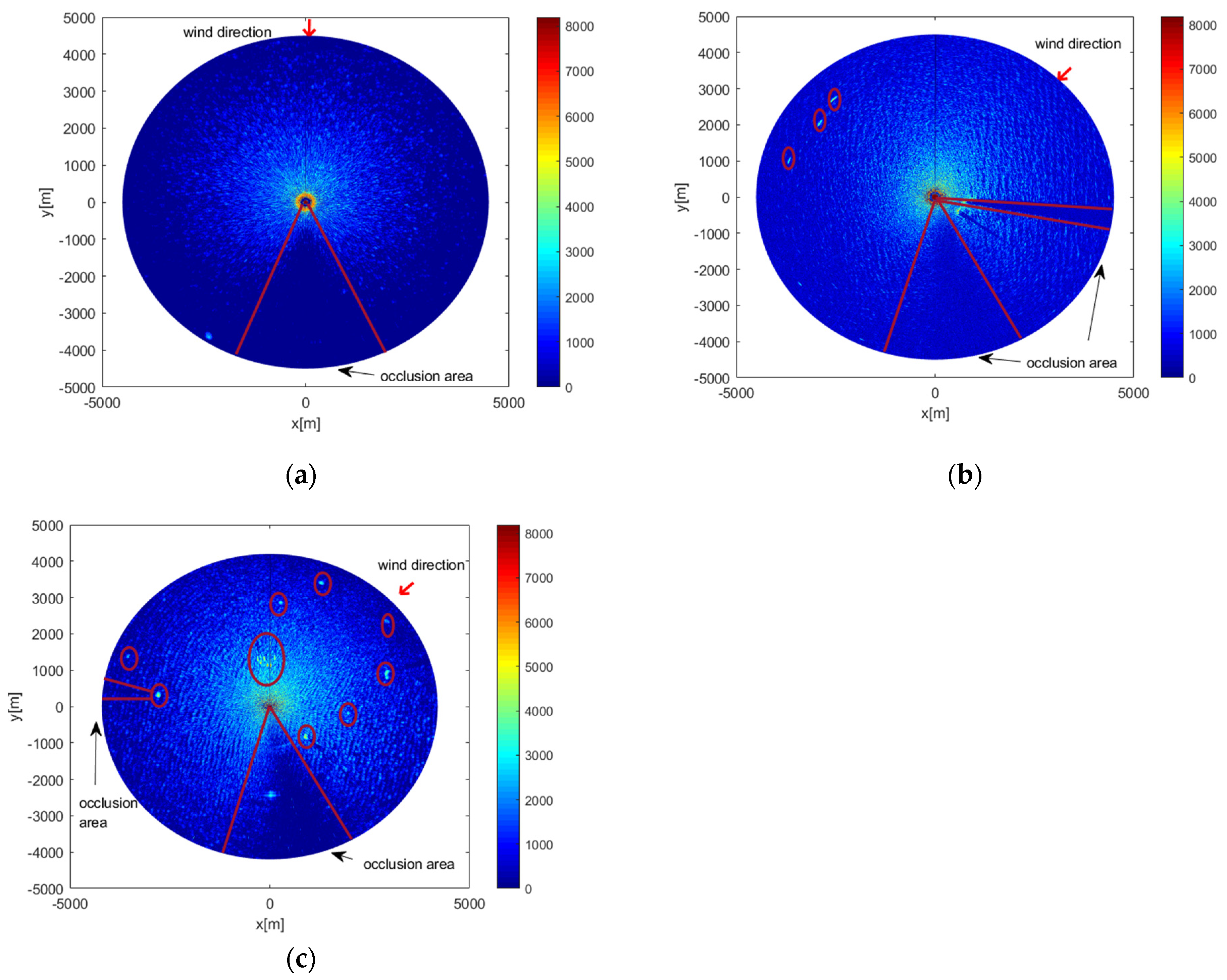

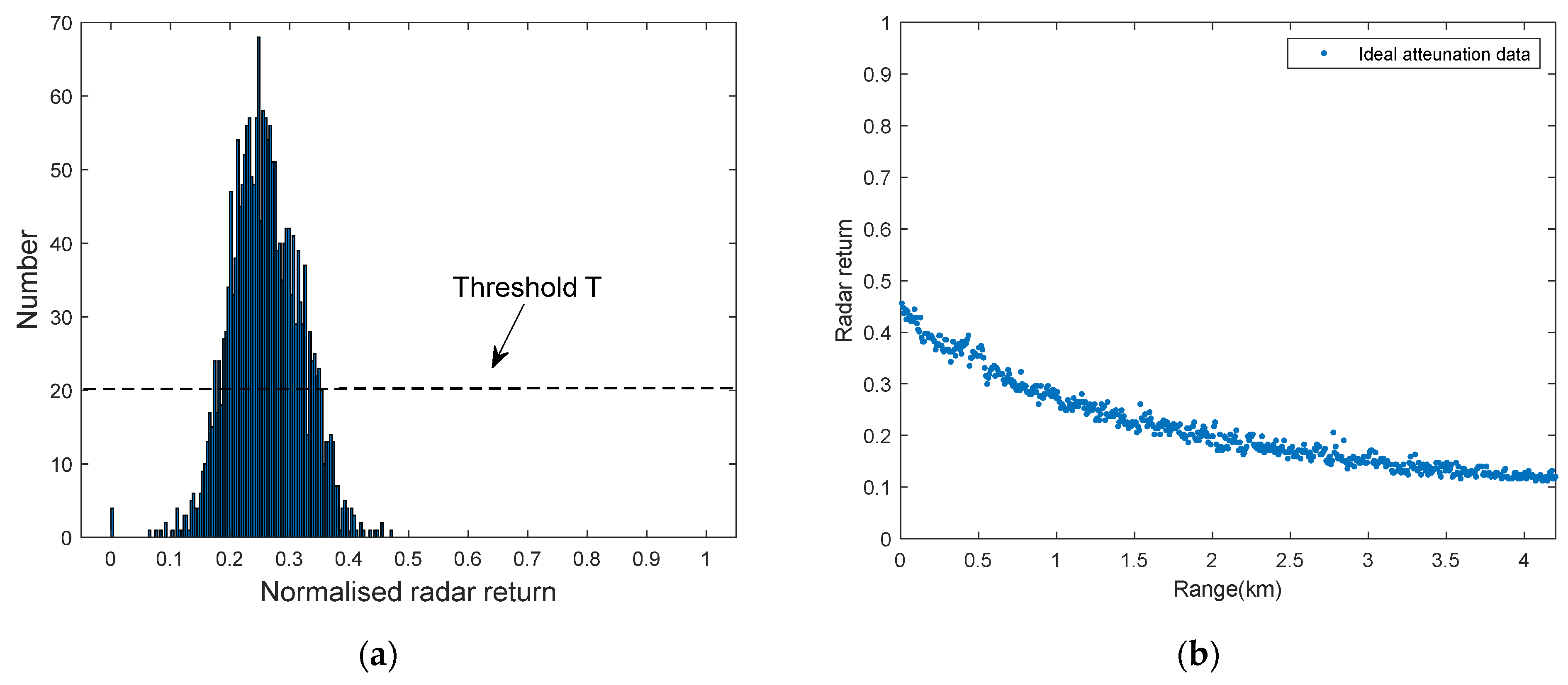
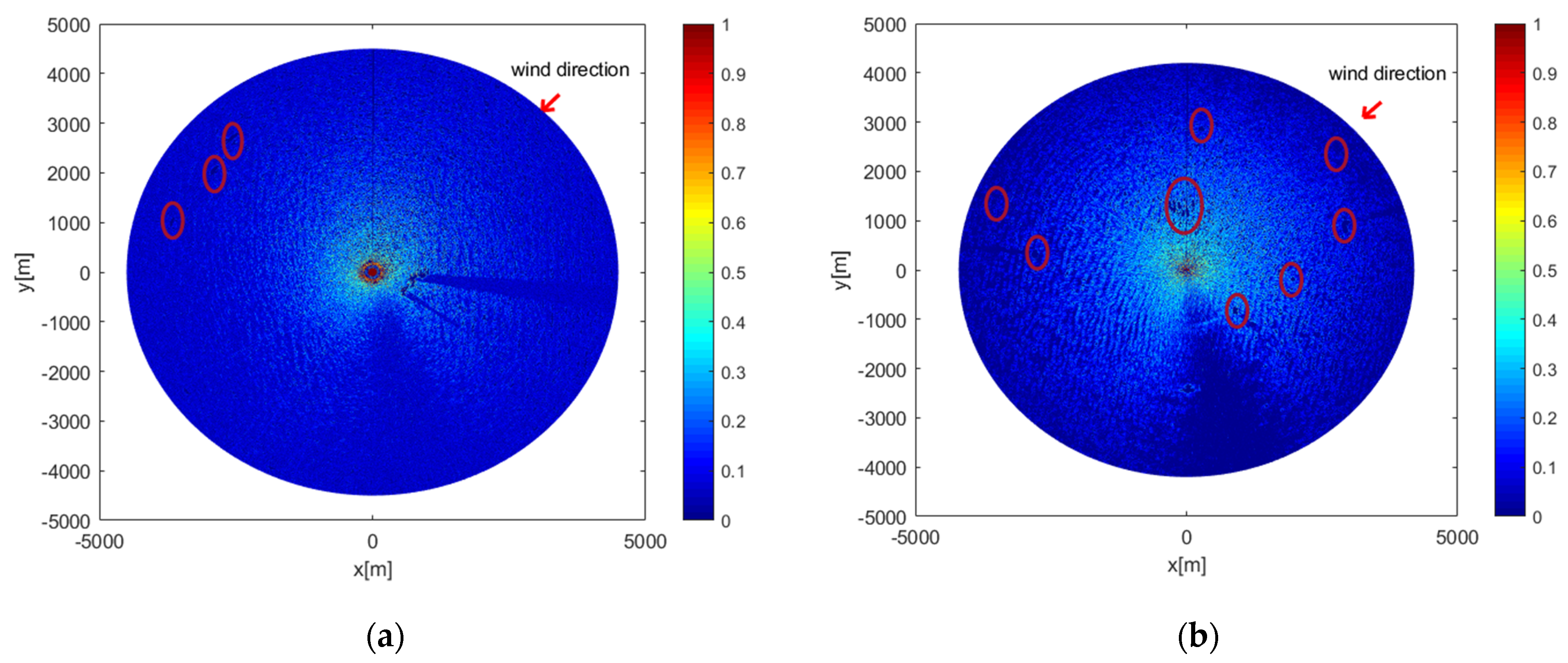
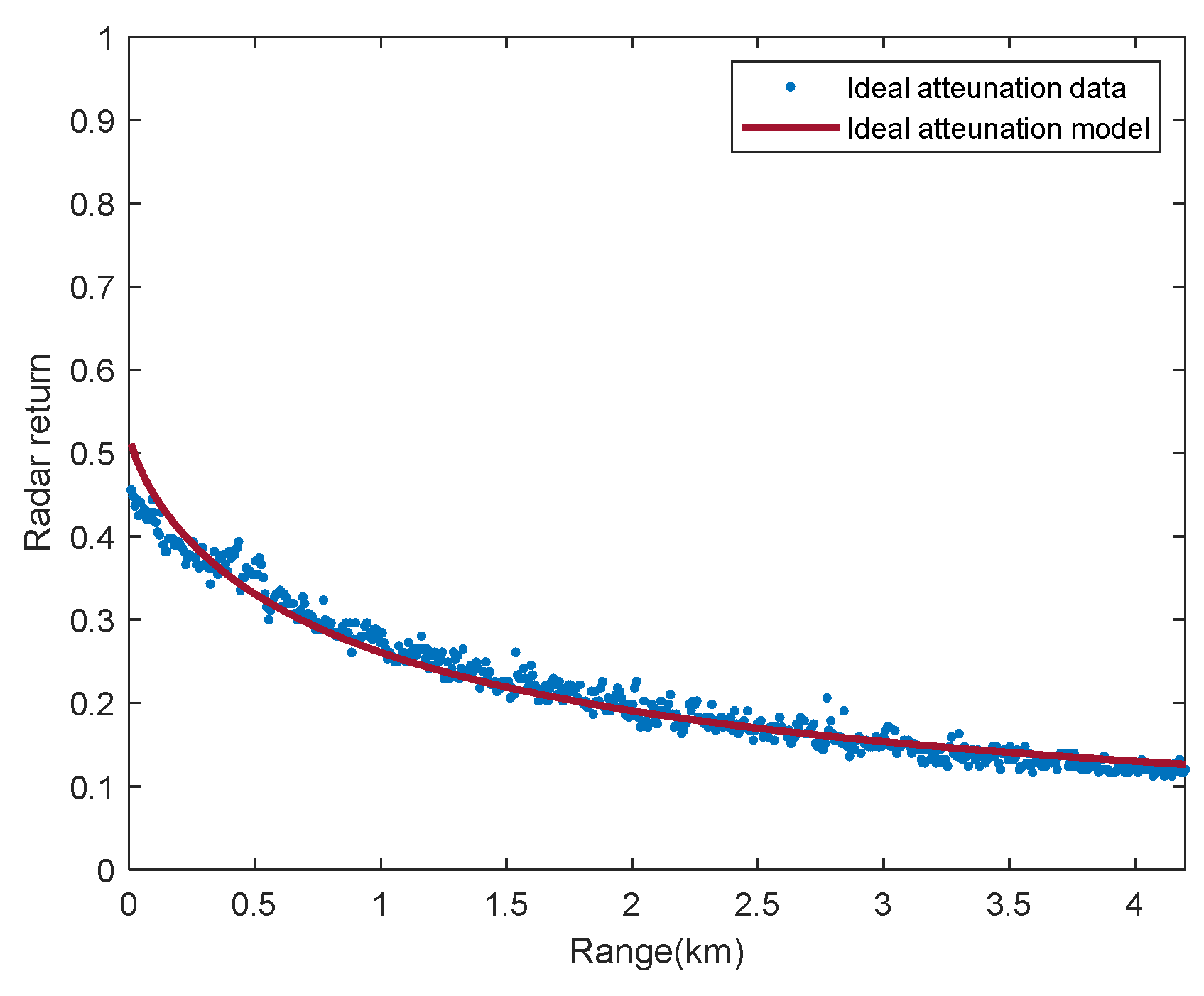

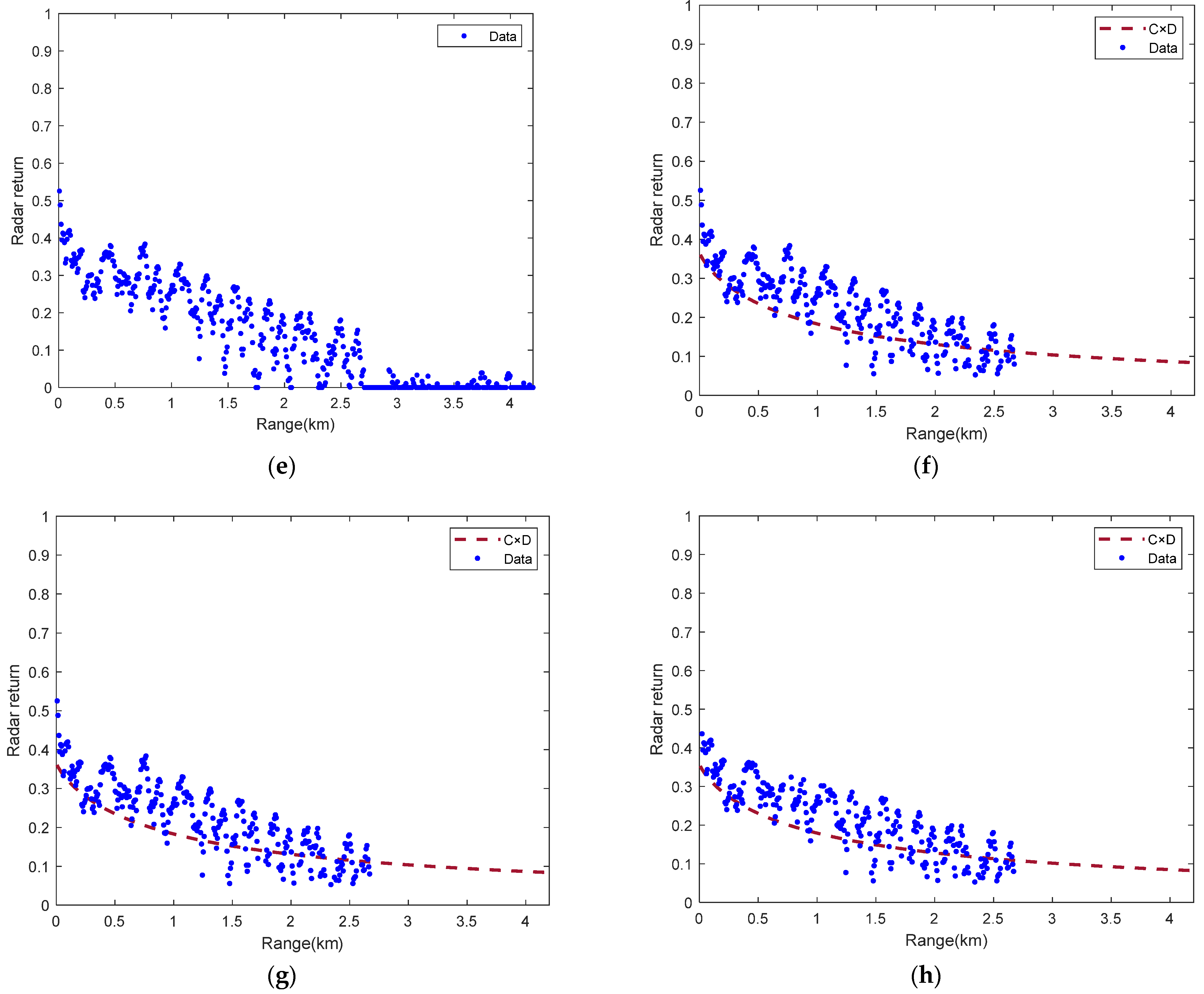
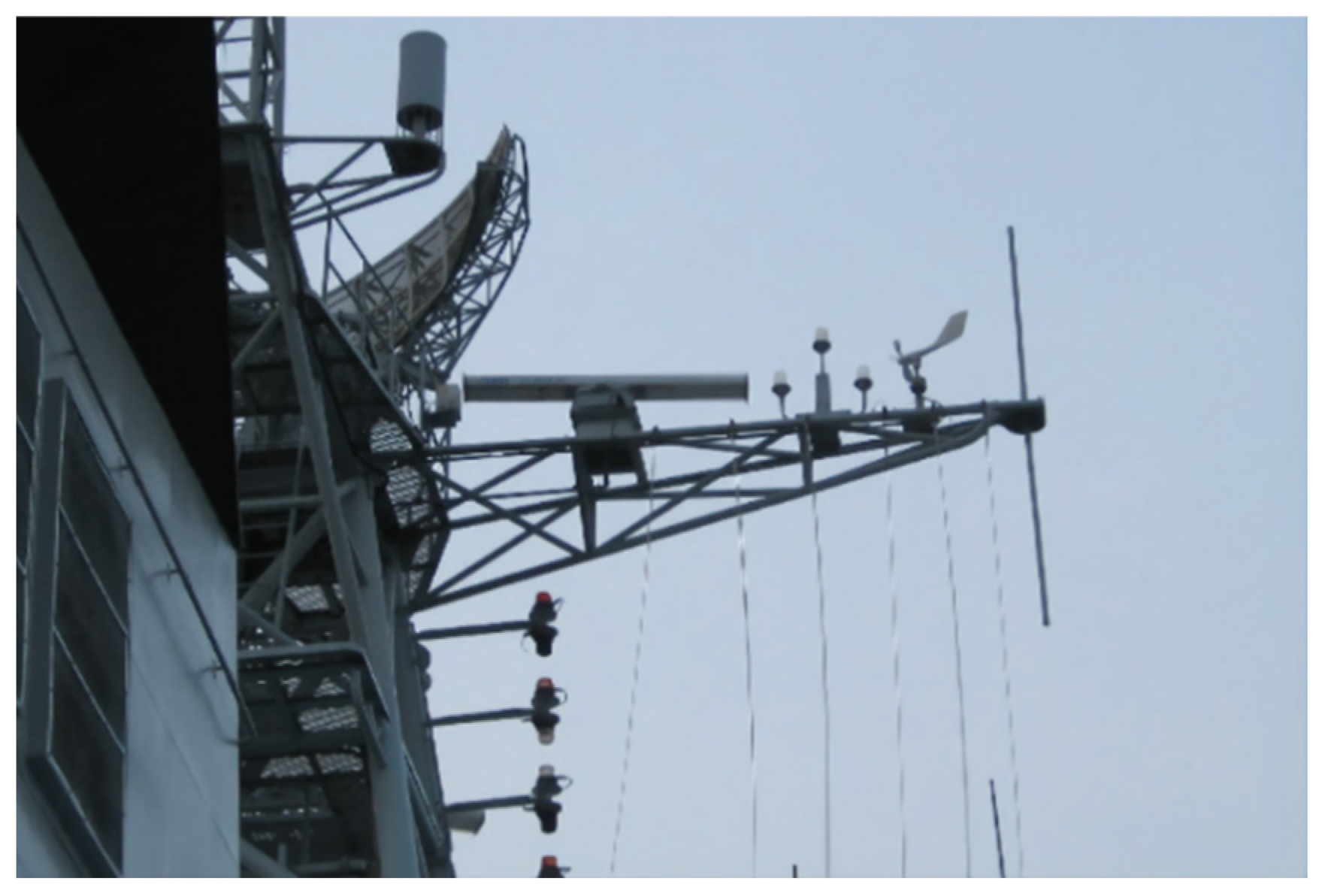
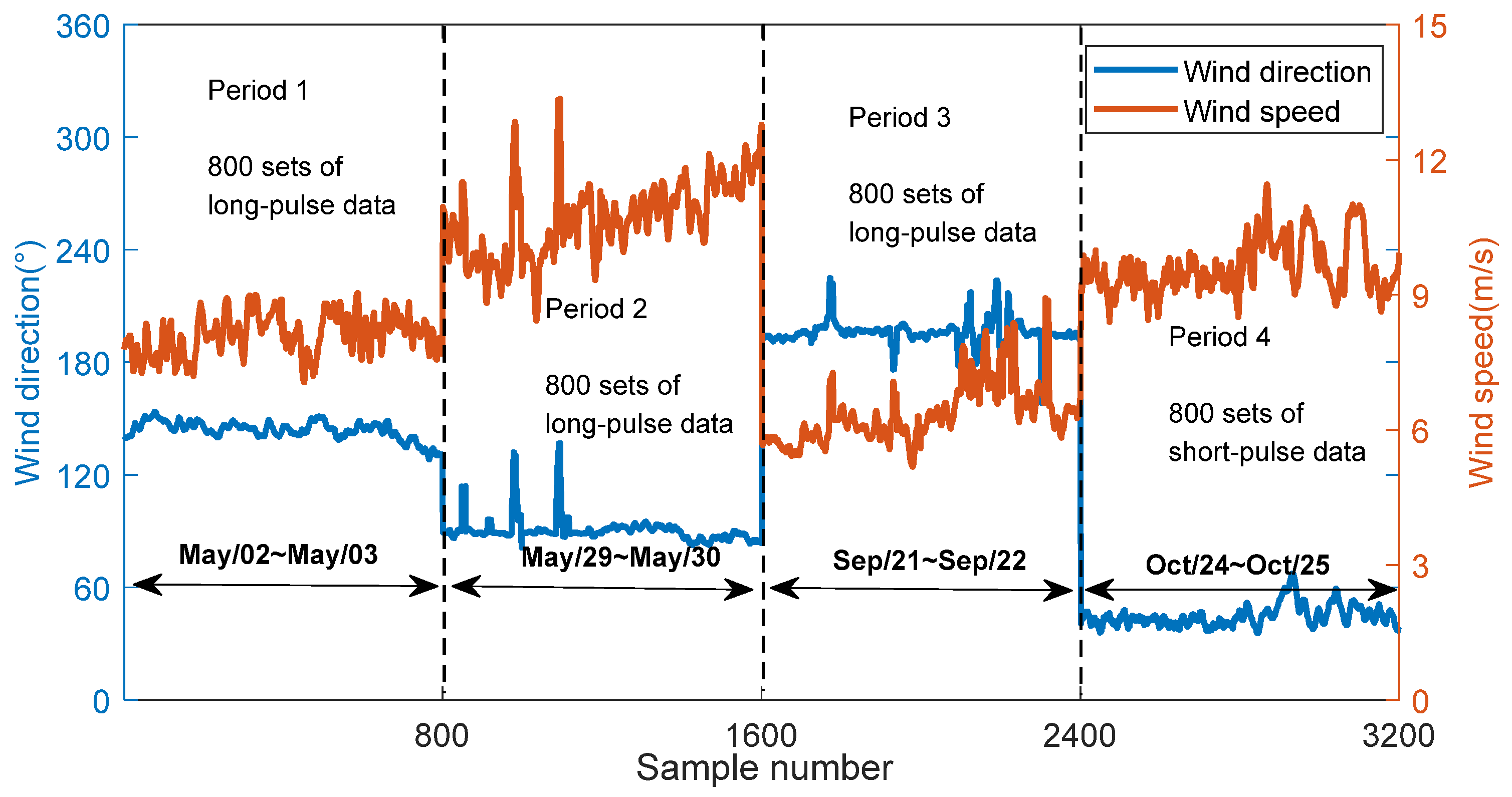



| Radar Parameters | The Performance |
|---|---|
| Electromagnetic wave frequency | 9.4 GHz |
| Polarization | HH |
| Antenna height | 25 m |
| Antenna angular speed | 24 rpm |
| Range resolution | 7.5 m |
| Horizontal beam width | 1.3° |
| Pulse width (long-pulse) | |
| Pulse width (short-pulse) | |
| Grazing angle | <5° |
| Period | Average Wind Speed | Single Curve Fitting | Attenuation Horizontal Component Method | ||
|---|---|---|---|---|---|
| Deviation (°) | RMSE (°) | Deviation (°) | RMSE (°) | ||
| 1 | 8.1 m/s | 11.4° | 12.5° | 8.8° | 9.5° |
| 2 | 10.7 m/s | 11.8° | 13.5° | 6.0° | 7.9° |
| 3 | 6.3 m/s | 16.8° | 17.4° | 5.9° | 8.6° |
| The first half of 4 | 9.3 m/s | 12.3° | 13.1° | 4.9° | 7.3° |
| The second half of 4 | 9.9 m/s | 24.2° | 25.1° | 7.9° | 8.9° |
Disclaimer/Publisher’s Note: The statements, opinions and data contained in all publications are solely those of the individual author(s) and contributor(s) and not of MDPI and/or the editor(s). MDPI and/or the editor(s) disclaim responsibility for any injury to people or property resulting from any ideas, methods, instructions or products referred to in the content. |
© 2023 by the authors. Licensee MDPI, Basel, Switzerland. This article is an open access article distributed under the terms and conditions of the Creative Commons Attribution (CC BY) license (https://creativecommons.org/licenses/by/4.0/).
Share and Cite
Yu, H.; Lu, Z.; Wang, H. Wind Direction Extraction from X-Band Marine Radar Images Based on the Attenuation Horizontal Component. Remote Sens. 2023, 15, 3959. https://doi.org/10.3390/rs15163959
Yu H, Lu Z, Wang H. Wind Direction Extraction from X-Band Marine Radar Images Based on the Attenuation Horizontal Component. Remote Sensing. 2023; 15(16):3959. https://doi.org/10.3390/rs15163959
Chicago/Turabian StyleYu, Huanyu, Zhizhong Lu, and Hui Wang. 2023. "Wind Direction Extraction from X-Band Marine Radar Images Based on the Attenuation Horizontal Component" Remote Sensing 15, no. 16: 3959. https://doi.org/10.3390/rs15163959
APA StyleYu, H., Lu, Z., & Wang, H. (2023). Wind Direction Extraction from X-Band Marine Radar Images Based on the Attenuation Horizontal Component. Remote Sensing, 15(16), 3959. https://doi.org/10.3390/rs15163959






